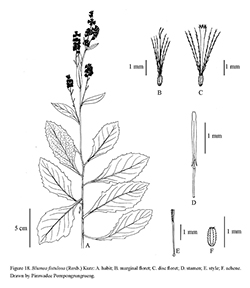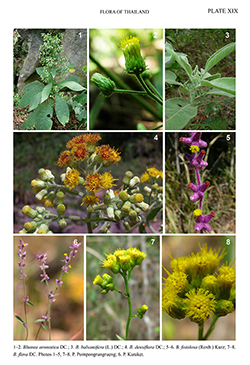e-Flora of Thailand
Volume 13 > Part 2 > Year 2016 > Page 206 > Compositae (Asteraceae) > Blumea
5. Blumea fistulosa (Roxb.) Kurzwfo-0000069656
J. Asiat. Soc. Bengal, Pt. 2, Nat. Hist. 39(2): 187. 1877; Kerr, Fl. Siam. 2(3): 257. 1936; Randeria, Blumea 10: 256. 1960.— Conyza fistulosa Roxb., Fl. Ind. 3: 429. 1832. Fig. 18; Plate XIX: 5–6.
Accepted Name : This is currently accepted.
Synonyms & Citations :
Description : Annual herb, 0.2–1 m tall; stems erect, glabrous to pubescent. Leaves sessile, elliptic, lanceolate, ovate or lacerate with 2 lobes, 3.5–17 by 0.5–6.5 cm, apex acute, base attenuate, margins serrate, dentate or rarely lacerate, bright green, upper surface glabrous, pubescent, rarely scabrous or tomentose, lower surface pubescent, tomentose or sometimes woolly. Inflorescences terminal and/or axillary, interrupted spiciform panicles, 5–35 cm long. Capitula 3–6 mm diam.; peduncles 0–0.5 mm long; involucres campanulate; phyllaries (3–) 5-seriate, reddish purple, outer ovate or lanceolate, 0.3–1 mm wide, puberulous with stipitate glands, apex acute, inner herbaceous with broad scarious margins, with pilose hairs and stipitate glands; receptacle 2.5–3 mm diam., flat, alveolate, pubescent or pilose. Marginal floret corollas yellow, basal tube 2.5–5.8 mm long, lobes glabrous with scattered glandular hairs. Disc floret corollas yellow, basal tube 2.5–6.8 mm long, glabrous, lobes oblong-lanceolate, 0.2–0.6 mm long, pubescent with unicellular and glandular hairs; anthers 1.1–2.5 mm long, apical appendages round, bases with unbranched tails, anther-tails shorter than anther collars; style arms 0.6–1.2 mm long; base swollen. Achenes elliptic or oblong, 4–8-ribbed, 0.4–1 mm long, setuliferous; pappus bristles 10–15, 2.6–5.5 mm long, caducous, white.
Thailand : NORTHERN: Mae Hong Son (Pai WS, Mo Paeng Falls, Mae Sariang, Huai Hi), Chiang Mai (Doi Chang, Doi Chiang Dao, Doi Inthanon, Doi Mae Ya, Doi Pui, Doi Suthep, Mae Taman Reforestation Unit, Bo Luang, Pha Hom Pok, Muang to Yang, Ban Mae Khon, Mae Sanam, Hot, Mae Sao Watershed Management Station, Om Koi, Pine Improvement Centre, Fang to Chiang Rai along route 109, Doi Ruea Wuak), Chiang Rai (Chiang Khan, Pang Kia, Mae Sai, Doi Tung, Ban Hua Suek), Lampang (Ban Mae Thak, Huai Maesan, Hangchat, Doi Khun Tan, Mae Tha), Phrae (Huai Rong, Den Chai), Tak; NORTH-EASTERN: Phetchabun (Pha Daeng Cliff, Nam Nao NP), Loei (Phu Kradueng, Phu Luang), Nakhon Phanom (Dongman), Mukdahan; EASTERN: Nakhon Ratchasima (Khao Khiao to Wang Takrai Falls, Khao Yai NP); SOUTH-WESTERN: Uthai Thani (Ma Di river area, Huai Kha Khaeng WS); Kanchanaburi (Huai Lam Ton to Erawan Falls); SOUTH-EASTERN: Prachin Buri, Chon Buri (Nong Yai Bu, Sri Racha).
Distribution : China (Hainan, Guangdong, Yunnan, Guizhou, Guangxi, Hong Kong), India (type), Bhutan, Nepal, Myanmar, Indochina.
Ecology : Among grasses in oak forests, humus-rich slopes in open hill evergreen, mixed deciduous, dry dipterocarp forests, clearings in limestone areas, 200–1,600 m alt. Flowering: October–March.
Vernacular : Khon bung (ขนบุ้ง)(Loei); pat hin (ปัดหิน)(Chiang Rai, Loei); phakkat khima (ผักกาดขี้หมา)(Chiang Mai); phaya roi rak (พญาร้อยราก)(Loei); nat kham (หนาดคำ)(Chiang Mai, Phrae, Northern).


